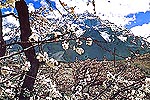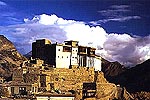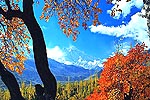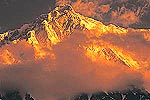 Lord Curzon, a former viceroy, said, "The little state of Hunza contains more summits of over 20,000 feet than there are
of over 10,000 feet in the entire Alps." Visitors to Hunza are deeply overwhelmed
by the rugged charm and the fragrant breeze singing through graceful trees
and the lushious green attractively carpeted fields all set against a background
of snow-covered mountains. Situated at an elevation of 2,438 metres, Hunza
Valley's tourist season peaks from May to October. The temperature in May
is 27 C maximum and 14 C minimum. While the October temperatures range
from: 10 C maximum to 0 C minimum.
Lord Curzon, a former viceroy, said, "The little state of Hunza contains more summits of over 20,000 feet than there are
of over 10,000 feet in the entire Alps." Visitors to Hunza are deeply overwhelmed
by the rugged charm and the fragrant breeze singing through graceful trees
and the lushious green attractively carpeted fields all set against a background
of snow-covered mountains. Situated at an elevation of 2,438 metres, Hunza
Valley's tourist season peaks from May to October. The temperature in May
is 27 C maximum and 14 C minimum. While the October temperatures range
from: 10 C maximum to 0 C minimum.
Glaciers abound in this valley, including the 30-mile long Batura and the immense Virjerab
 and Hispar glaciers. The Nubra, Braldu, Hushe
and Saltoro rivers are born in the glacier-laced Karakorum; the Shyok River
encircles the eastern flanks of the range; but only the Hunza River actually
cuts from north to south completely through the Karakorum Range. The Hunza
River has its origin in name at the juncture of the Kilik and Khunjerab
nalas, some 100 miles from the river's mouth near Gilgit. Carving a gorge
between 25,000-foot peaks and receiving the waters of scores of glaciers,
this is by far the largest and the grandest tributory of the Gilgit River
watershed.
and Hispar glaciers. The Nubra, Braldu, Hushe
and Saltoro rivers are born in the glacier-laced Karakorum; the Shyok River
encircles the eastern flanks of the range; but only the Hunza River actually
cuts from north to south completely through the Karakorum Range. The Hunza
River has its origin in name at the juncture of the Kilik and Khunjerab
nalas, some 100 miles from the river's mouth near Gilgit. Carving a gorge
between 25,000-foot peaks and receiving the waters of scores of glaciers,
this is by far the largest and the grandest tributory of the Gilgit River
watershed.
Most parts of Hunza offer an awe-inspiring view of Rakaposhi (7,788 metres). The snows of Rakaposhi glitter in the moonlight, producing an atmosphere of ethereal magnetism. The fairy-tale like castle of Baltit, just above Karimabad, is a Hunza landmark built about 600 years ago. Stilted on massive legs, its wooden bay windows look out over the valley. Originally, this was used as the residence of the Mirs (the title of the former rules) of Hunza.
The Hunza Valley is composed of "Hunza Proper" (as Hunzakuts call it) in the midvalley,
 while the larger upper valley region is called
Gujal and is populated by the Wakhi-speaking ethnic Wakhi. Nagar, another
former state, is located in two areas, and you will visit its narrow glaciated
canyons as you proceed up the valley. The Nagarwals speak Burushaski with
their own accent. Practice your Burushaski, with those you meet; people
will enjoy it, and you may be asked in for tea. Burushaski is a complex
language with four genders, and it is a "language isolate," unrelated to
any other tongue. The famous Hunza water (famous for long life and youth)
is locally called "mel". Four clans live in Hunza, and each is said to
have originally come from a different region: Dramatin from Tartary, Barataling
from Russia, Kurukutz from Persia, and Broung from kashmir.
while the larger upper valley region is called
Gujal and is populated by the Wakhi-speaking ethnic Wakhi. Nagar, another
former state, is located in two areas, and you will visit its narrow glaciated
canyons as you proceed up the valley. The Nagarwals speak Burushaski with
their own accent. Practice your Burushaski, with those you meet; people
will enjoy it, and you may be asked in for tea. Burushaski is a complex
language with four genders, and it is a "language isolate," unrelated to
any other tongue. The famous Hunza water (famous for long life and youth)
is locally called "mel". Four clans live in Hunza, and each is said to
have originally come from a different region: Dramatin from Tartary, Barataling
from Russia, Kurukutz from Persia, and Broung from kashmir.
The 6-mile long fertile oasis beginning at Hassanabad contains small villages among terraced fields and is the center of the former state. Not far beyond Aliabad a link road branches uphill to the north of the KKH (Karakorum Highway)and is the direct way to Karimabad and Baltit (65 miles from Gilgit and ranging 500 feet up and down the hill at roughly 7,800 feet in elevation). Because of their inns and their spectacular location overlooking Rakaposhi and the green fields of Hunza and nagar, these two towns, Kareemabad in particular, function as the focus of Hunza for most visitors.
 Just beyond 'Ganesh Village' below Kareemabad, the KKH (Karakorum Highway) crosses the Hunza river on a large, graceful
bridge. Within walking distance from the bridge right on the roadside is
'Haldikish' (Place of the Rams), also known as the "Sacred Rock" of Hunza.
This large rock has many carvings from different eras and in varying scripts.
At Shiskot the KKH crosses the west side of the river and soon reaches
Gulmit (about 8,000 feet). Gulmit has a couple of lodges and the town in
itself, is an attractive one to visit. Just above the lodges is the Hunza
Cultural Museum.
Just beyond 'Ganesh Village' below Kareemabad, the KKH (Karakorum Highway) crosses the Hunza river on a large, graceful
bridge. Within walking distance from the bridge right on the roadside is
'Haldikish' (Place of the Rams), also known as the "Sacred Rock" of Hunza.
This large rock has many carvings from different eras and in varying scripts.
At Shiskot the KKH crosses the west side of the river and soon reaches
Gulmit (about 8,000 feet). Gulmit has a couple of lodges and the town in
itself, is an attractive one to visit. Just above the lodges is the Hunza
Cultural Museum.
Hunza is an ideal place for mountaineering, trekking and hiking. Every area in the Hunza Valley up to, but not including , Chapursan is officially considered an openzone, even the dicey Hispar Glacier. Most treks in this valley are'nt particularly long ones but there are exceptions; the Hispar-Biafo walk and the hike to Shimshal are among such exceptions. Hunza genuinely offers an experience of a lifetime!
More Information


